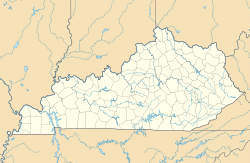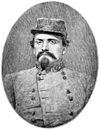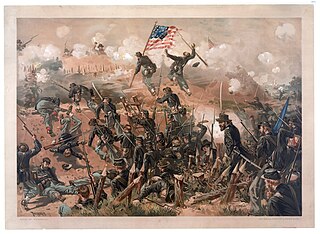
The siege of Vicksburg was the final major military action in the Vicksburg campaign of the American Civil War. In a series of maneuvers, Union Major General Ulysses S. Grant and his Army of the Tennessee crossed the Mississippi River and drove the Confederate Army of Mississippi, led by Lieutenant General John C. Pemberton, into the defensive lines surrounding the fortress city of Vicksburg, Mississippi, leading to the successful siege and Confederate surrender.

The Battle of Arkansas Post, also known as Battle of Fort Hindman, was fought from January 9 to 11, 1863, along the Arkansas River at Arkansas Post, Arkansas, as part of the Vicksburg campaign of the American Civil War. Confederate forces had constructed a fort known as Fort Hindman near Arkansas Post in late 1862. Also in late 1862, Major General John A. McClernand of the Union Army was authorized to recruit troops in the midwest in preparation for an expedition down the Mississippi River against Vicksburg, Mississippi. Union Major General Ulysses S. Grant began an overland campaign against Vicksburg along the Mississippi Central Railroad in November. Grant and Major General Henry Halleck did not trust McClernand, and machinated start the riverine movement south against Vicksburg under the command of Major General William T. Sherman before McClernand could arrive. Sherman's movement was defeated in the Battle of Chickasaw Bayou in late December, and Confederate cavalry raids forced Grant to abandon his overland campaign.

The Battle of Perryville, also known as the Battle of Chaplin Hills, was fought on October 8, 1862, in the Chaplin Hills west of Perryville, Kentucky, as the culmination of the Confederate Heartland Offensive during the American Civil War. Confederate Gen. Braxton Bragg's Army of Mississippi initially won a tactical victory against primarily a single corps of Maj. Gen. Don Carlos Buell's Union Army of the Ohio. The battle is considered a strategic Union victory, sometimes called the Battle for Kentucky, since Bragg withdrew to Tennessee soon thereafter. The Union retained control of the critical border state of Kentucky for the remainder of the war.

The Battle of Kelly's Ford, also known as the Battle of Kellysville or Kelleysville, took place on March 17, 1863, in Culpeper County, Virginia, as part of the cavalry operations along the Rappahannock River during the American Civil War. It set the stage for Brandy Station and other cavalry actions of the Gettysburg Campaign that summer. Twenty-one hundred troopers of Brig. Gen. William W. Averell's Union cavalry division crossed the Rappahannock to attack the Confederate cavalry that had been harassing them that winter. Brig. Gen. Fitzhugh Lee counterattacked with a brigade of about 800 men. After achieving a localized success, Union forces withdrew under pressure in late afternoon, without destroying Lee's cavalry.

The Battle of Belmont was fought on November 7, 1861, in Mississippi County, Missouri. It was the first combat test in the American Civil War for Brig. Gen. Ulysses S. Grant, the future Union Army general in chief and eventual U.S. president, who was fighting Major General Leonidas Polk. Grant's troops in this battle were the "nucleus" of what would become the Union Army of the Tennessee.
The Battle of Hartsville was fought on December 7, 1862, in northern Tennessee at the opening of the Stones River Campaign the American Civil War. Hartsville Battlefield is listed on the National Register of Historic Places.
The First Battle of Murfreesboro was fought on July 13, 1862, in Rutherford County, Tennessee, as part of the American Civil War. Troops under Confederate cavalry commander Brig. Gen. Nathan Bedford Forrest surprised and quickly overran a Federal hospital, the camps of several small Union units, and the jail and courthouse in Murfreesboro, Tennessee. All of the Union units surrendered to Forrest, and the Confederates destroyed much of the Union's supplies and destroyed railroad track in the area. The primary consequence of the raid was the diversion of Union forces from a drive on Chattanooga.

The Battle of Munfordville was an engagement in Munfordville, Kentucky during the American Civil War. Victory there allowed the Confederates to temporarily strengthen their hold on the region and impair Union supply lines.

The Battle of Jonesborough was fought between Union Army forces led by William Tecumseh Sherman and Confederate forces under William J. Hardee during the Atlanta Campaign in the American Civil War. On the first day, on orders from Army of Tennessee commander John Bell Hood, Hardee's troops attacked the Federals and were repulsed with heavy losses. That evening, Hood ordered Hardee to send half his troops back to Atlanta. On the second day, five Union corps converged on Jonesborough. For the only time during the Atlanta Campaign, a major Federal frontal assault succeeded in breaching the Confederate defenses. The attack took 900 prisoners, but the defenders were able to halt the breakthrough and improvise new defenses. Despite facing overwhelming odds, Hardee's corps escaped undetected to the south that evening.

Morgan's Raid was a diversionary incursion by Confederate cavalry into the Union states of Indiana, Kentucky, Ohio, and West Virginia during the American Civil War. The raid took place from June 11 to July 26, 1863. It is named for the commander of the Confederate troops, Brigadier General John Hunt Morgan. Although it caused temporary alarm in the North, the raid failed.

The Battle of Corydon was a minor engagement that took place July 9, 1863, just south of Corydon, which had been the original capital of Indiana until 1825, and was the county seat of Harrison County. The attack occurred during Morgan's Raid in the American Civil War as a force of 2,500 cavalry invaded the North in support of the Tullahoma Campaign. It was the only pitched battle of the Civil War that occurred in Indiana, and no battle has occurred within Indiana since.
The Battle of Buffington Island, also known as the St. Georges Creek Skirmish, was an American Civil War engagement in Meigs County, Ohio, and Jackson County, West Virginia, on July 19, 1863, during Morgan's Raid. The largest battle in Ohio during the war, Buffington Island contributed to the capture of the Confederate Brig. Gen. John Hunt Morgan, who was fleeing U.S. Army soldiers across the Ohio River at a ford opposite Buffington Island.
The Battle of Lebanon occurred July 5, 1863, in Lebanon, Kentucky, during Morgan's Raid in the American Civil War. Confederate troops under Brig. Gen. John Hunt Morgan fought for six hours to overcome the small U.S. garrison before moving northward, eventually riding through Kentucky, Indiana, and much of Ohio before surrendering.

Kentucky was a southern border state of key importance in the American Civil War. It officially declared its neutrality at the beginning of the war, but after a failed attempt by Confederate General Leonidas Polk to take the state of Kentucky for the Confederacy, the legislature petitioned the Union Army for assistance. Though the Confederacy controlled more than half of Kentucky early in the war, after early 1862 Kentucky came largely under U.S. control. In the historiography of the Civil War, Kentucky is treated primarily as a southern border state, with special attention to the social divisions during the secession crisis, invasions and raids, internal violence, sporadic guerrilla warfare, federal-state relations, the ending of slavery, and the return of Confederate veterans.

The Battle of Tebb's Bend Monument in Taylor County, Kentucky, near Campbellsville, Kentucky, commemorates the Battle of Tebbs Bend, which occurred on July 4, 1863, during the Civil War. The battle is considered a Union victory, as it greatly delayed John Hunt Morgan's famous Raid that would later go into Indiana and Ohio.
The Civil War Trust's Civil War Discovery Trail is a heritage tourism program that links more than 600 U.S. Civil War sites in more than 30 states. The program is one of the White House Millennium Council's sixteen flagship National Millennium Trails. Sites on the trail include battlefields, museums, historic sites, forts and cemeteries.

The 6th Texas Cavalry Regiment was a unit of mounted volunteers that fought in the Confederate States Army during the American Civil War. The regiment fought at Chustenahlah in 1861. The following year the unit fought at Pea Ridge, First Corinth, Second Corinth, Hatchie's Bridge, and Holly Springs. The 6th Texas Cavalry participated in the fighting at Thompson's Station in 1863, the Atlanta campaign, and the Franklin–Nashville Campaign in 1864. The regiment formally surrendered to Union forces in May 1865 and its remaining soldiers were paroled.

The Battle of Riggins Hill was a minor engagement in western Tennessee during the American Civil War. A Confederate raiding force under Colonel Thomas Woodward captured Clarksville, Tennessee, threatening Union shipping on the Cumberland River. Several Union regiments led by Colonel William Warren Lowe advanced from nearby Fort Donelson and drove off the Confederates after a struggle lasting less than an hour. The action occurred during the Confederate Heartland Offensive but only affected the local area.
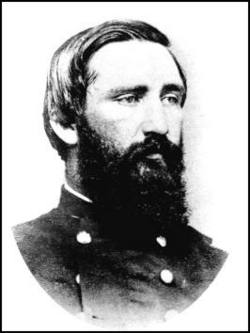
Sanders' Knoxville Raid saw 1,500 Union cavalry and mounted infantry led by Colonel William P. Sanders raid East Tennessee before the Knoxville campaign during the American Civil War. The successful raid began at Mount Vernon, Kentucky and moved south, passing near Kingston, Tennessee. Moving east from the Kingston area, the raiders struck the East Tennessee and Georgia Railroad at Lenoir Station. The Union horsemen rode northeast along the railroad, destroying track, bridges, and property useful to the Confederate States of America. Blocked from seizing Knoxville by its 1,000 Confederate defenders, Sanders' horsemen destroyed a major bridge across the Holston River at Strawberry Plains on the East Tennessee and Virginia Railroad. After wrecking a smaller bridge at Mossy Creek, the raiders turned northwest, evading pursuers by slipping through an obscure gap in the Cumberland Plateau. Sanders' men reached Boston, Kentucky on June 24, having captured and paroled over 400 Confederate soldiers while sustaining minimal losses in men but considerable losses in horses.
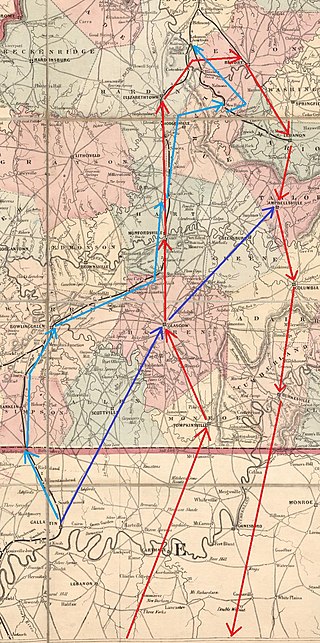
Morgan's Christmas Raid was carried out by Confederate Brigadier General John Hunt Morgan between December 22, 1862, and January 5, 1863. Morgan intended to cut the supply lines to the Union Army of the Cumberland in Tennessee. The Union used the Louisville and Nashville Railroad, and Morgan had identified two 500-foot (150 m) long trestle bridges at Muldraugh Hill that could be burnt. Morgan's 4,000-strong cavalry force left Alexandria, Tennessee, on December 22 and passed into Kentucky on Christmas Eve, defeating part of the 2nd Michigan Cavalry Regiment near Tompkinsville. They fought and defeated an Indiana cavalry detachment on Christmas Day at Bear Wallow, Barren County. The U.S. Army sent forces under Colonel John Marshall Harlan and Major General Joseph J. Reynolds to try to catch Morgan. However, Morgan used ruses to distract his pursuers. Morgan captured a Union stockade at Bonnieville on December 26 and on December 27 captured Elizabethtown before burning the bridges at Muldraugh Hill.

